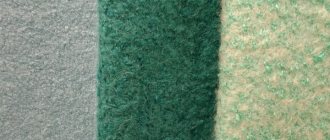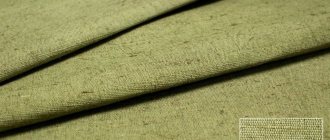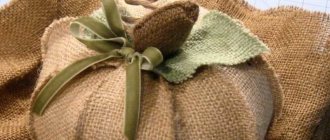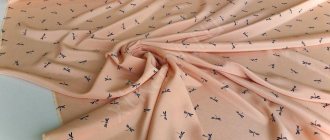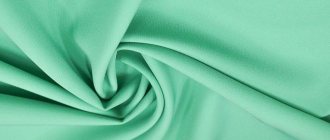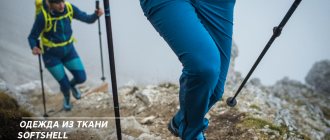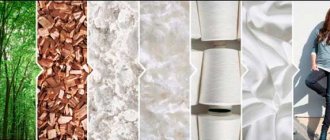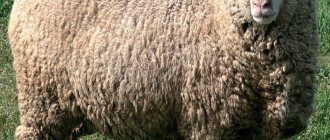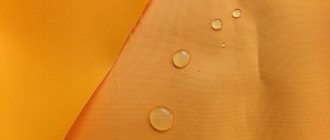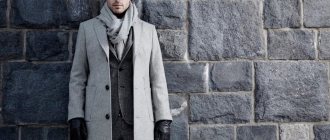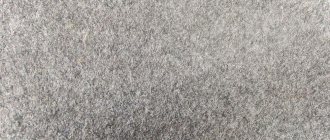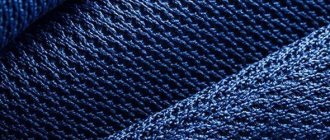Canvas is a fabric that is often compared to canvas due to its external similarity. The canvas consists of two layers and is impregnated with Teflon or wax. Thanks to this structure, it is durable, resistant to moisture and dirt. This makes it possible to use the material not only for sewing everyday clothes, but also for making bags, shoes, and military uniforms.
What type of fabric is this?
Canvas is a durable, dense material made from synthetic and natural fibers. Same on both sides. Outwardly similar to tarpaulin, but soft, comfortable, pleasant to the touch.
Tarpaulin
Strength and wear resistance: an overview of the properties of tarpaulin fabric
more details
The fabrics are made on looms using the method of double weaving of warp and longitudinal threads. The outer layers are made of synthetics - polyester with the addition of nylon. The main (inner) layer is made of polyester and cotton or linen fibers.
Canvas colors
Untreated (harsh) canvases are impregnated with compounds that repel water and dirt. Impregnations are made on the basis of wax and Teflon. Materials are painted in natural or bright colors. Drawings are applied to the surface. Workwear and sporting goods are made from canvas. Used to decorate rooms, make covers, awnings.
Care
Products made from this material do not require special care; it is enough to follow a few simple rules:
- If there is no heavy contamination, simply vacuum the item or brush it with a dry brush.
- If the dirt is serious, you can use a sponge dipped in soapy water.
- You can wash things either by hand or in a washing machine, temperature – no higher than 30 degrees
- The material dries almost instantly, you just need to shake the thing
- Such products do not require ironing
Origin story
The name of the fabric comes from the Latin word canuabis - hemp. The ancient Greeks and Romans made durable materials from hemp. The predecessor of canvas is considered to be a material for sails.
The canvas was made from hemp and impregnated with beeswax. Later, flax and cotton were used simultaneously with hemp. Durable materials repelled moisture and did not deteriorate in sea water.
From the late 15th to early 19th centuries, canvas was a strategic commodity. After the advent of steamships, its importance decreased. The material was used to make things for the navy, army, peasant clothing, and luggage covers. After the advent of synthetics, durable waterproof items are made from mixed fabrics protected with impregnations.
Advantages and disadvantages of the material
Canvas was invented more than 700 years ago. During this time, its composition was changed and improved many times. Matter is still popular. This is due to its advantages:
- Wear resistance. The fabric is highly durable, does not stretch, does not thin, and does not fade over time. Canvas is subject to signs of aging, but it only looks more noble with them. The matter is not direction-finding, that is, it is not covered with pellets. No snags are formed on the material, and fibers are not pulled out of it.
- Easy to care for. The material does not attract dust, dirt, does not wrinkle, and has dirt-repellent properties. Any dirt can be easily removed from it even with dry cleaning.
- Pleasant tactile sensations. Despite the fact that the material is durable, it is soft and pleasant to wear. Does not cause irritation even to sensitive skin.
- Moisture-repellent properties. Bags and shoes made of canvas do not get wet even in a downpour.
- Breathability. The material allows the skin to breathe. It is suitable for making summer shoes.
- Color fastness. The fabric does not fade or fade. Dyes penetrate deeply into the structure of its fibers.
The disadvantages of the fabric include:
- Low hygroscopicity. Therefore, it is not suitable for sewing summer clothes.
- Possibility of washout of impregnation due to improper care. In this case, the textile will lose its water-repellent properties.
- Low elasticity. The fabric does not stretch or drape. It is not suitable for sewing all styles of clothing.
Pros and cons of fabric
Advantages:
- Wear resistance, strength, durability.
- Repels moisture and dirt. Reliably protects from snow and rain.
- Despite the high density, it is soft, pleasant to the touch, and comfortable.
- Lets air through.
- Just take care. Does not wrinkle, dries quickly, and is easy to clean.
- Does not deform.
- Doesn't roll down.
- No puffs are formed.
- Paints well.
- Does not allow light to pass through.
- Doesn't fade.
- It ages beautifully when worn.
Flaws:
- Low elasticity.
- When washing, the impregnation is washed out.
- Due to low hygroscopicity, it is suitable only for outerwear.
- Impregnations are harmful to allergy sufferers.
Application
What is this fabric suitable for? Its application is quite wide.
- Covering for sofas and other upholstered furniture. Canvas furniture fabric is good, first of all, because the owner of such a piece of furniture can forget about stains on the upholstery (and such a nuisance, you see, does not happen rarely)
- Canvas is an excellent fabric for sewing curtains - it is soft to the touch, breathable, and strong. In addition, canvas curtain fabric can be of a variety of shades, which remain bright for a long time and do not fade in the sun. By the way, Blackout is a fabric that is also perfect for making curtains; it does not allow sunlight to pass through, which is perfect for those who like to sleep in complete darkness.
- In bags and backpacks, this material can be both the lining and the main fabric. These backpacks are good for everyday use, for tourism, and for sports.
- Sports, work and military uniforms
- Hats
- Cases
- Shoes
Examples of canvas products can be seen in the photo.
What standards are used in production? What do they take into account?
The raw material for canvas is predominantly polyester, a type of polyester fiber. GOST 27504-87 establishes for harsh polyester fabrics:
- technical requirements;
- acceptance and testing rules;
- conditions of transportation and storage;
- Manufacturers' warranties.
The requirements are stated:
- for sizes;
- for physical and mechanical properties;
- permissible deviations;
- labeling, packaging.
Compound
This material is mixed. The canvas fabric may contain linen or cotton as a natural component. And to give greater density and wear resistance, synthetic fibers are used. By the way, the distinctive feature of this canvas is that it is two-layer:
Upper layer:
- Polyester – 85%
- Nylon – 15%
Base layer:
- Polyester – 65%
- Linen or cotton – 35%
Additionally, this material is impregnated with Teflon or the same wax.
Canvas. How to deal with him
Have a good day and good health everyone.
I want to talk about some points related to canvas, which I have collected in one post. This is the result of collecting information from reviews of customers who have already used or continue to use canvas.
Let me start with the fact that canvas is a fairly strong material, no matter what density it is - 8, 12, 16, 24 ounces. (Density for fabric is the weight of one square meter of fabric). So a properly selected canvas will last a long time.
Canvas is used for sewing aprons, backpacks, bags, upholstery, pillows, table textiles, hats, shoes, curtains, houses and carriers for children and pets. Some types of canvas are well used for sewing clothes: overalls, jackets, pants, trench coats, shorts, skirts. Write to me what you want to sew, and I will guide you according to the canvas that will suit you.
Now to how to sew, wash, and so on.
All canvas that is presented in my store is cotton. There is 100% cotton canvas, there is a mixture of cotton and jute, cotton with the addition of polyester (70/30) - (some marble colors). But it's always cotton at the base.
Cotton has a number of properties, one of which is that it shrinks. This is his natural quality. And this must be kept in mind for canvas. He can sit down. Moreover, the ability to shrink depends on the color and composition, that is, it is difficult to say in advance exactly how much it will shrink after the first wash. That's why:
Wet and dry the fabric before cutting. Soak by hand or machine wash on low speed. Hang carefully, smoothing out wrinkles, and let dry naturally. Do not use powder; liquid detergent or regular soap is better.
Some shades of canvas are bright and rich. This is not forever, unfortunately. After several washes and exposure to the sun, bright canvas may turn a little grey. Some dark shades may lose color a little in the creases after washing, and you may end up with a “marbled” material when it comes out of the washing machine. Some people like it, some don't, keep that in mind.
Bright or dark shades, due to their coloring, can stain the lighter parts of the product if they touch or rub against each other! Therefore, be sure to soak bright and dark fabrics, let the top colorful color come off before sewing, and only then combine.
It is also better to pre-soak marble canvases so that shrinkage occurs before cutting.
There are some canvases that have been pre-washed at the factory, these are sea and warm gray shades. You don't have to do anything with them before cutting.
The black and dark blue canvases that I sell are reactive in color. This means that they should not produce light marbling marks on the fabric after washing. But these fabrics must be soaked before cutting, since they have an active top layer of paint and it is better for it to come off before sewing. The same goes for black cotton cord, which is dyed using the same reactive method.
Marble canvases should not lose color. Bright and dark regular colors can turn grey.
Waxed canvases. Waxed canvases are good because they are impregnated with wax on both sides, which makes the apron waterproof (for florists) and hairproof (for salons). But after vigorous washing, the wax will simply come off the fabric. Therefore, it is better not to wash products made from waxed canvas, but to wipe them with a damp cloth. Also, for waxed canvases, light arrows at the folds are natural. Waxed canvas holds its shape well. Impregnation with wax has its own peculiarity - if you rub the fabric with your hands, thereby heating it, then the feeling of wax remains on your hands.
An important observation is that no matter how thick and dense the canvas is, over time it will become soft. Therefore, if you are planning a product with an exact shape, place it on a reinforcement, seal, lining, or mold.
If you are sewing a product from canvas that will be washed during wear, treat it with a water- and dirt-repellent agent before wearing, this will reduce the number of washes.
About sewing. In general, any hobby machine will handle 16 oz canvas if you sew two layers. If there are three layers (hemming), then a reinforced needle may be needed. Everyone has different needles and capabilities, so keep in mind that you may need help.
As for color, I’ll say the usual words - to accurately convey the color in a photo is a utopia. Some complex shades produce different colors at different times of the day and season. The same shade next to others gives a different idea of oneself. In general, color has many nuances. That's why I sometimes write the Panton color number, which you can google and see what the color looks like. Plus, you can always describe any color in words. This is where colors such as waffle, spruce, sea, tangerine appear in my store
Important observation: canvas is made from thick threads, which may not be perfect. Sometimes there are threads of other shades, there are compactions and tubercles. This is living tissue, this is normal. If you want a perfect canvas, then this is not for me)) I have everything alive))
And one last thing. If you have a demanding project, or you want to know exactly the shade and how the fabric will behave after washing, ask for samples. They are free.
Diana
Canvas products
As in the past, clothing is made from this material, most often for work and outdoor activities. However, in many popular styles, such as country, boho, ethnic, hippie, jackets, vests, shoes and especially canvas bags are also popular.
However, bags made of this fabric attract not only fans of extravagant styles. They are comfortable, strong, durable and also look aesthetically pleasing, but without being too pretentious.
Canvas bag - what is it? This is the ideal accessory for a business person living a dynamic, active life. And women's models are not devoid of elegance and are no less stylish than leather ones.
Shoes are made from canvas for those who prefer a sporty style. Sneakers, sneakers, moccasins, and espadrilles made from this material are popular among people of different ages. They are comfortable, not hot in summer and warm in cool weather.
Canvas is an excellent fabric for upholstery. And furniture makers willingly use it along with jacquard and leather, especially since it is no less durable than these materials. In the furniture industry, a special type of canvas developed by Arben is most often used.
The material is also used to make canvas awnings, tents, collapsible gazebos, tents, curtains and much more.
But the use of this fabric is not limited to the production of purely utilitarian items. Canvas prints – what are they? These are magnificent paintings and photographs. The structure of the fabric allows you to apply a three-dimensional pattern of any complexity to it, and the unique texture creates the impression of handmade work.
Advantages of innovative canvas
Canvas fabric now resembles its “great-grandfather” only in its special weaving. Otherwise, this is a completely new, high-tech material that is in demand not only among furniture manufacturers, but also among fashion brands.
Comparison of paintings
It is chosen due to some characteristics that are necessary for sewing truly durable things:
- Durability is the calling card of canvas. This is the most durable material available with an impressive service life.
- Resistance to deformation comes from strength, but here we cannot help but add that the fabric does not wrinkle.
- The canvas is not covered with pellets throughout the entire period of use.
- Breathability is ensured by weaving.
- Moisture resistance thanks to Teflon impregnation.
Moisture resistance
- Softness and tactile pleasantness provided by the addition of cotton or linen.
- Color preservation.
- Caring for the fabric is more than simple and quick, especially since the fabric dries quickly.
Important: The wear resistance of canvas material is 10 times higher than the requirements according to GOST. Products live with their owners all their lives without deformation. And even after aging, the canvas does not lose its charm, since abrasions and cracks give the fabric a new sound, creating a unique, inimitable pattern.
Origin and external characteristics
During its history, which dates back to the ancient era, canvas material has repeatedly changed both its purpose and composition. The stems of hemp, cultivated in Mediterranean countries, were torn and treated with candle wax. From the resulting plant threads they wove a two-layer fabric, from which sailors made sails that could withstand strong gusts of wind and not get wet in the rain.
In Latin the material was called canuabis, in France – canevas, in the Russian Empire – canvas.
In the 18th century, stronger linen and cotton fabrics began to be used to equip ships, from which they later began to sew workwear and uniforms for sailors. The technology for producing canvas has been improved over time, but the structure of the fabric has not been changed, as before; canvas is a two-layer material that is distinguished by a designated interweaving of threads. Modern fabric differs from ancient canvas with improved characteristics, bright patterns and designs.
Varieties
It is possible to classify canvas according to density indicators. This is determined by the number of threads in one square centimeter. There are two options:
- 180–240 gsm cm is a thin material that is usually used to make clothes;
- from 320 g/sq.m. cm is a denser fabric that is used for sewing bags and shoes.
